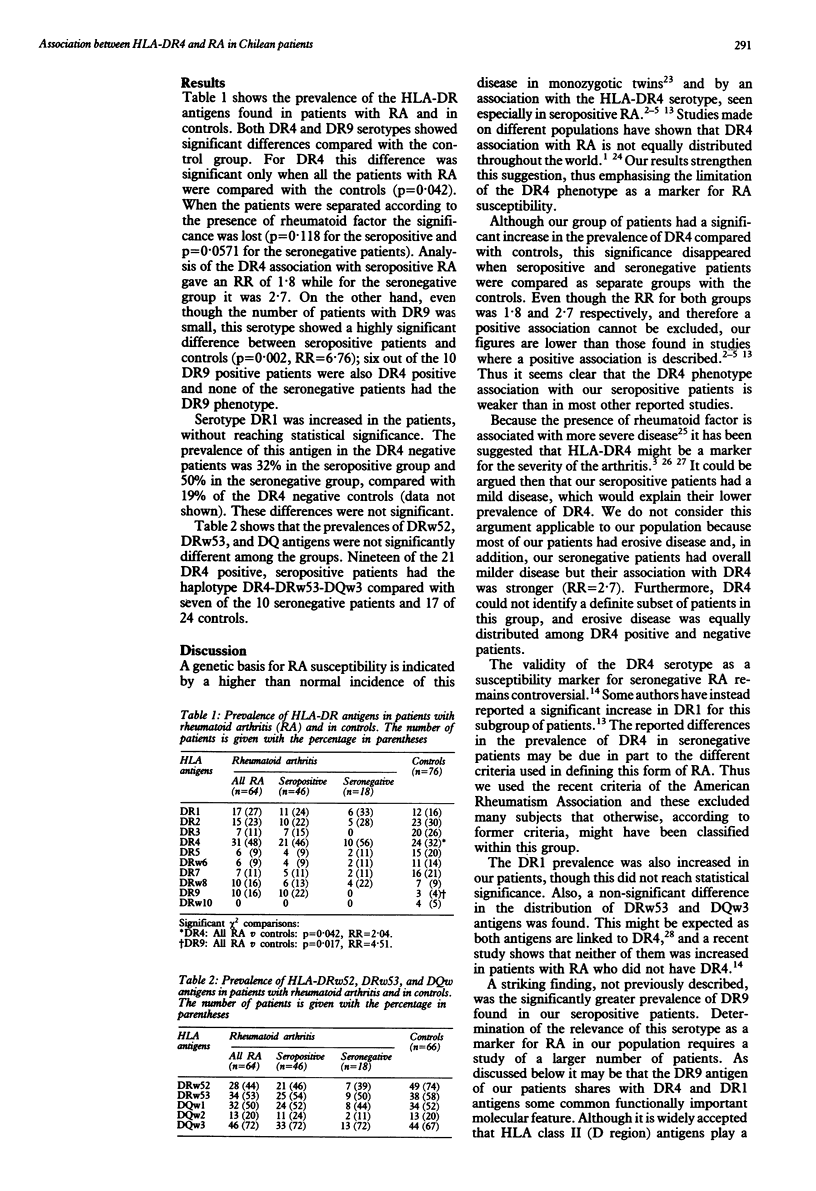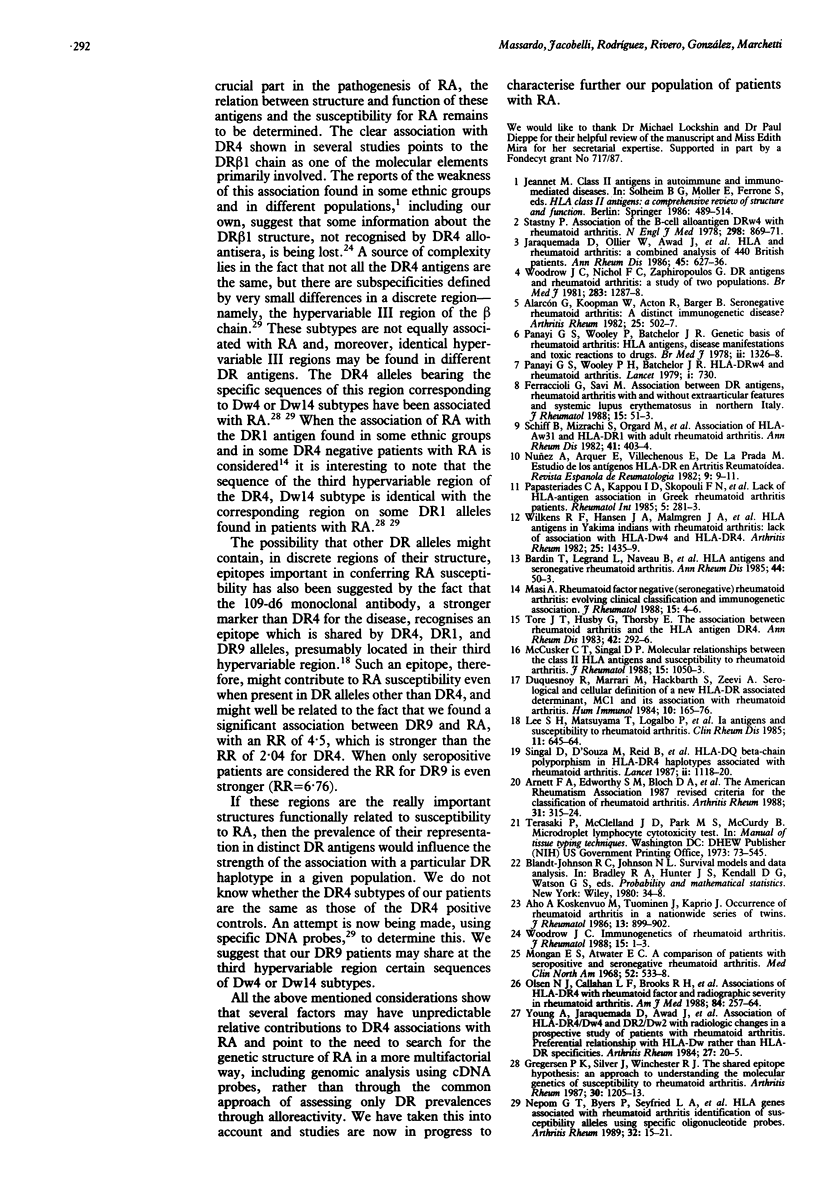Abstract
Evidence has suggested a genetic link between the HLA-DR4 phenotype and rheumatoid arthritis (RA), particularly in its seropositive form. Such an association varies among different ethnic groups and remains controversial for seronegative patients. Data obtained for a group of 64 Chilean patients with RA (46 seropositive, 18 seronegative), as defined by the 1987 criteria of the American Rheumatism Association, and for 76 controls are reported here. The prevalence of HLA-DR4 and DR9 was significantly increased in the group of patients considered as a whole. The prevalence of HLA-DR4 was not significantly higher, however, when seronegative and seropositive patients were separately compared with controls. Also, it did not correlate with the severity of the disease within each subgroup of patients. On the other hand, HLA-DR9 showed a highly significant difference, not previously described, only for the seropositive patients in comparison with controls. The prevalence of DQ specificities showed no relevant differences among the groups. The HLA-DR4 serotype, therefore, is a weak marker for RA and does not differentiate any subgroup of patients in the Chilean group studied. This new finding, indicating an association between RA and the DR9 antigen, may be explained by the suggestion that susceptibility epitopes are shared among different DR molecules. This hypothesis might also account for the variation in the association of DR4 with RA.
Full text
PDF


Selected References
These references are in PubMed. This may not be the complete list of references from this article.
- Aho K., Koskenvuo M., Tuominen J., Kaprio J. Occurrence of rheumatoid arthritis in a nationwide series of twins. J Rheumatol. 1986 Oct;13(5):899–902. [PubMed] [Google Scholar]
- Alarcón G. S., Koopman W. J., Acton R. T., Barger B. O. Seronegative rheumatoid arthritis. A distinct immunogenetic disease? Arthritis Rheum. 1982 May;25(5):502–507. doi: 10.1002/art.1780250503. [DOI] [PubMed] [Google Scholar]
- Arnett F. C., Edworthy S. M., Bloch D. A., McShane D. J., Fries J. F., Cooper N. S., Healey L. A., Kaplan S. R., Liang M. H., Luthra H. S. The American Rheumatism Association 1987 revised criteria for the classification of rheumatoid arthritis. Arthritis Rheum. 1988 Mar;31(3):315–324. doi: 10.1002/art.1780310302. [DOI] [PubMed] [Google Scholar]
- Bardin T., Legrand L., Naveau B., Marcelli-Barge A., Debeyre N., Lathrop G. M., Poirier J. C., Schmid M., Ryckewaert A., Dryll A. HLA antigens and seronegative rheumatoid arthritis. Ann Rheum Dis. 1985 Jan;44(1):50–53. doi: 10.1136/ard.44.1.50. [DOI] [PMC free article] [PubMed] [Google Scholar]
- Duquesnoy R. J., Marrari M., Hackbarth S., Zeevi A. Serological and cellular definition of a new HLA-DR associated determinant, MC1, and its association with rheumatoid arthritis. Hum Immunol. 1984 Jul;10(3):165–176. doi: 10.1016/0198-8859(84)90037-5. [DOI] [PubMed] [Google Scholar]
- Ferraccioli G., Savi M. Association between DR antigens, rheumatoid arthritis with and without extraarticular features and systemic lupus erythematosus in northern Italy. J Rheumatol. 1988 Jan;15(1):51–53. [PubMed] [Google Scholar]
- Gran J. T., Husby G., Thorsby E. The association between rheumatoid arthritis and the HLA antigen DR4. Ann Rheum Dis. 1983 Jun;42(3):292–296. doi: 10.1136/ard.42.3.292. [DOI] [PMC free article] [PubMed] [Google Scholar]
- Gregersen P. K., Silver J., Winchester R. J. The shared epitope hypothesis. An approach to understanding the molecular genetics of susceptibility to rheumatoid arthritis. Arthritis Rheum. 1987 Nov;30(11):1205–1213. doi: 10.1002/art.1780301102. [DOI] [PubMed] [Google Scholar]
- Jaraquemada D., Ollier W., Awad J., Young A., Silman A., Roitt I. M., Corbett M., Hay F., Cosh J. A., Maini R. N. HLA and rheumatoid arthritis: a combined analysis of 440 British patients. Ann Rheum Dis. 1986 Aug;45(8):627–636. doi: 10.1136/ard.45.8.627. [DOI] [PMC free article] [PubMed] [Google Scholar]
- Masi A. T. Rheumatoid factor negative (seronegative) rheumatoid arthritis: evolving clinical classification and immunogenetic associations. J Rheumatol. 1988 Jan;15(1):4–6. [PubMed] [Google Scholar]
- McCusker C. T., Singal D. P. Molecular relationships between the class II HLA antigens and susceptibility to rheumatoid arthritis. J Rheumatol. 1988 Jul;15(7):1050–1053. [PubMed] [Google Scholar]
- Mongan E. S., Atwater E. C. A comparison of patients with seropositive and seronegative rheumatoid arthritis. Med Clin North Am. 1968 May;52(3):533–538. [PubMed] [Google Scholar]
- Nepom G. T., Byers P., Seyfried C., Healey L. A., Wilske K. R., Stage D., Nepom B. S. HLA genes associated with rheumatoid arthritis. Identification of susceptibility alleles using specific oligonucleotide probes. Arthritis Rheum. 1989 Jan;32(1):15–21. doi: 10.1002/anr.1780320104. [DOI] [PubMed] [Google Scholar]
- Olsen N. J., Callahan L. F., Brooks R. H., Nance E. P., Kaye J. J., Stastny P., Pincus T. Associations of HLA-DR4 with rheumatoid factor and radiographic severity in rheumatoid arthritis. Am J Med. 1988 Feb;84(2):257–264. doi: 10.1016/0002-9343(88)90422-6. [DOI] [PubMed] [Google Scholar]
- Panayi G. S., Wooley P. H., Batchelor J. R. HLA-DRw4 and rheumatoid arthritis. Lancet. 1979 Mar 31;1(8118):730–730. doi: 10.1016/s0140-6736(79)91186-3. [DOI] [PubMed] [Google Scholar]
- Panayi G. S., Wooley P., Batchelor J. R. Genetic basis of rheumatoid disease: HLA antigens, disease manifestations, and toxic reactions to drugs. Br Med J. 1978 Nov 11;2(6148):1326–1328. doi: 10.1136/bmj.2.6148.1326. [DOI] [PMC free article] [PubMed] [Google Scholar]
- Schiff B., Mizrachi Y., Orgad S., Yaron M., Gazit E. Association of HLA-Aw31 and HLA-DR1 with adult rheumatoid arthritis. Ann Rheum Dis. 1982 Aug;41(4):403–404. doi: 10.1136/ard.41.4.403. [DOI] [PMC free article] [PubMed] [Google Scholar]
- Singal D. P., D'Souza M., Reid B., Bensen W. G., Kassam Y. B., Adachi J. D. HLA-DQ beta-chain polymorphism in HLA-DR4 haplotypes associated with rheumatoid arthritis. Lancet. 1987 Nov 14;2(8568):1118–1120. doi: 10.1016/s0140-6736(87)91548-0. [DOI] [PubMed] [Google Scholar]
- Stastny P. Association of the B-cell alloantigen DRw4 with rheumatoid arthritis. N Engl J Med. 1978 Apr 20;298(16):869–871. doi: 10.1056/NEJM197804202981602. [DOI] [PubMed] [Google Scholar]
- Willkens R. F., Hansen J. A., Malmgren J. A., Nisperos B., Mickelson E. M., Watson M. A. HLA antigens in Yakima Indians with rheumatoid arthritis. Lack of association with HLA-Dw4 and HLA-DR4. Arthritis Rheum. 1982 Dec;25(12):1435–1439. doi: 10.1002/art.1780251208. [DOI] [PubMed] [Google Scholar]
- Woodrow J. C. Immunogenetics of rheumatoid arthritis. J Rheumatol. 1988 Jan;15(1):1–3. [PubMed] [Google Scholar]
- Woodrow J. C., Nichol F. E., Zaphiropoulos G. DR antigens and rheumatoid arthritis: a study of two populations. Br Med J (Clin Res Ed) 1981 Nov 14;283(6302):1287–1288. doi: 10.1136/bmj.283.6302.1287. [DOI] [PMC free article] [PubMed] [Google Scholar]
- Young A., Jaraquemada D., Awad J., Festenstein H., Corbett M., Hay F. C., Roitt I. M. Association of HLA-DR4/Dw4 and DR2/Dw2 with radiologic changes in a prospective study of patients with rheumatoid arthritis. Preferential relationship with HLA-Dw rather than HLA-DR specificities. Arthritis Rheum. 1984 Jan;27(1):20–25. doi: 10.1002/art.1780270104. [DOI] [PubMed] [Google Scholar]


